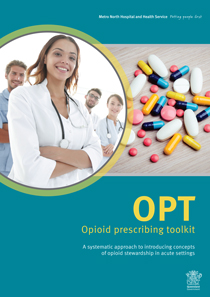About the Opioid Prescribing Toolkit
The place of opioids in the management of pain is well established. A trend in both increased prescribing and increased opioid related harm been observed in the United States and Canada(1) and here in Australia (2-5). Leong et al reported a threefold increase of PBS opioid prescriptions in Australia between 1992 to 2007(6).
Several practice improvement initiatives deployed at the Royal Brisbane and Women’s Hospital (RBWH) have successfully reduced the number of opioid doses prescribed at the point of hospital discharge and improved communication to the general practitioners.
Consistent across these projects are the tenets that appropriate prescribing of opioids is a balance between pain management and the risk of medication related harm, that rigorous quality improvement will reduce the likelihood of adverse patient outcomes, and that including a de-escalation plan in discharge communication will ensure patients are not re-prescribed opiates inappropriately. Opioid stewardship is a systematic approach to managing opioid prescribing.
The Opioid Prescribing Toolkit (OPT) was developed to provide a framework for introducing the concepts of opioid stewardship to acute care settings.
Intervention
In addition, OPT recommends utilising implementation science strategies to identify and address specific barriers and enablers relevant to a local setting. Whilst OPT is based on improving oxycodone prescribing it can be adapted for the prescribing of all opioids or specific opioids.
The essential components of the OPT intervention that resulted in practice improvements include
- Practice evaluation – at baseline, during and post intervention
- Clinician education – providing details of local prescribing patterns and increasing awareness of the current opioid problem as well as appropriate pain management strategies
- Utilisation of a clinical champion within targeted areas
- Development of consensus based analgesia guidelines
OPT contains templates and instructions for the following:
- pre-implementation planning strategies and evaluation tools
- staff education, stakeholder agreement of opioid prescribing guidelines
- written patient information
- implementation science methodology – identifying champions, barriers and enablers and the culture of the organisation to help develop suitable interventions
The opioid prescribing intervention is multifaceted and may not be the right fit for all settings in its current form. Rather than enforcing fidelity, OPT encourages adaptive implementation with rapid plan-do-study-act (PDSA) cycles to assess whether the modified intervention is as effective as or more effective than the original intervention.
References
- Leung PTM, Macdonald EM, Stanbrook MB, Dhalla IA, Juurlink DN. A 1980 Letter on the Risk of Opioid Addiction. N Engl J Med. 2017;376(22):2194-5.
- Pilgrim JL, Yafistham SP, Gaya S, Saar E, Drummer OH. An update on oxycodone: lessons for death investigators in Australia. Forensic science, medicine, and pathology. 2015;11(1):3-12.
- Berecki-Gisolf J, Hassani-Mahmooei B, Clapperton A, McClure R. Prescription opioid dispensing and prescription opioid poisoning: Population data from Victoria, Australia 2006 to 2013. Australian and New Zealand journal of public health. 2017;41(1):85-91.
- Degenhardt L, Blanch B, Gisev N, Larance B, Pearson S. The POPPY Research Programme protocol: investigating opioid utilisation, costs and patterns of extramedical use in Australia. BMJ open. 2015;5(1):e007030.
- Hollingworth SA, Gray PD, Hall WD, Najman JM. Opioid analgesic prescribing in Australia: a focus on gender and age. Pharmacoepidemiology and drug safety. 2015;24(6):628-36.
- Leong M, Murnion B, Haber PS. Examination of opioid prescribing in Australia from 1992 to 2007. Intern Med J. 2009;39(10):676-81.
Contact us
Phone: (07) 3333 3333
Email: email@health.qld.gov.au


